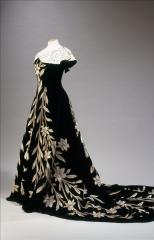Main menu
19th-Century Costumes Department
The 5,300 items in this department recount the history of fashion among France's upper classes from the Napoléonic period to around 1906, when Paul Poiret's 'Directoire' style dresses inaugurated 20th-century fashion. The collection is largely made up of clothes for women – 3,300 items – while men's and children's wear are represented by 1000 items each.
On the feminine side, the collection includes numerous garments worn by elegant members of the nobility and the upper middle classes: members of the First Empire court, among them the empresses Josephine and Marie-Louise; court women of the Restoration and Second Empire periods; and such influential late-century figures as Comtesse Greffulhe, a large part of whose wardrobe is kept in the museum. There are, too, garments worn by actresses like Sarah Bernhardt and beautiful demi-mondaines like Cléo de Mérode; as well as labelled items from such leading late-century couture houses as Pingat, Redfern, Rouff and Doucet, and pieces from smaller houses. Moreover, there are also quite a number from garments made by “confection”, the predecessor to today’s ready-to-wear, already on sale in the big Paris department stores like Au Printemps, Galeries Lafayette and Au Bon Marché.
Markedly fewer in number, the male items are mostly of a non-everyday character: prestigious civil uniforms, wedding clothes and evening wear. Similarly, the children's clothes tend to be those worn for ceremonies like baptisms and first communions.
The evolution of fashion in the 19th century is largely a matter of successive changes in the feminine silhouette. These were more and more frequent as the century wore on and fashion became a more democratic affair. Each period had its markers – the positioning of the waist, leg-o-mutton and pagoda sleeves, skirt shapes – which saw the 'column silhouettes' of the Empire and the late 1870s, for example, alternate with the 'hour glass' look that emphasised the waist and puffed out skirts out, as in the Romantic years of the 1830s. Throughout the century the female body was systematically transformed, becoming a 'fashion figure' whose shape was sculpted by its clothing. Menswear, by contrast, evolved much more slowly. Yielding to constant, century-long pressure from English fashion, male clothing eschewed the shimmering fabrics and intricate embroidery of the 18th century in favour of sober, modest wool. The sole exception here was the waistcoat, whose often vividly coloured fabrics harkened back to the exuberance of the preceding century.
-
Tea-gown, Worth
Voir la fiche de l'oeuvre
-
Coat of a Grand Marshal of the Palace
Voir la fiche de l'oeuvre
-
Bodice
Voir la fiche de l'oeuvre
-
Alfred de Musset's French Academy Uniform
Voir la fiche de l'oeuvre
-
Stage dress worn by Sarah Bernhardt
Voir la fiche de l'oeuvre
-
Sports corset
Voir la fiche de l'oeuvre
-
Day dress of the Maison Worth
Voir la fiche de l'oeuvre
-
Cyclist's bloomers
Voir la fiche de l'oeuvre
-
The 'Lily' evening gown, Worth
Voir la fiche de l'oeuvre
-
The Princesse d'Essling's wedding gown
Voir la fiche de l'oeuvre
-
Walking ensemble
Voir la fiche de l'oeuvre
-
Transformation dress
Voir la fiche de l'oeuvre
-
Réjane's tea-gown
Voir la fiche de l'oeuvre


